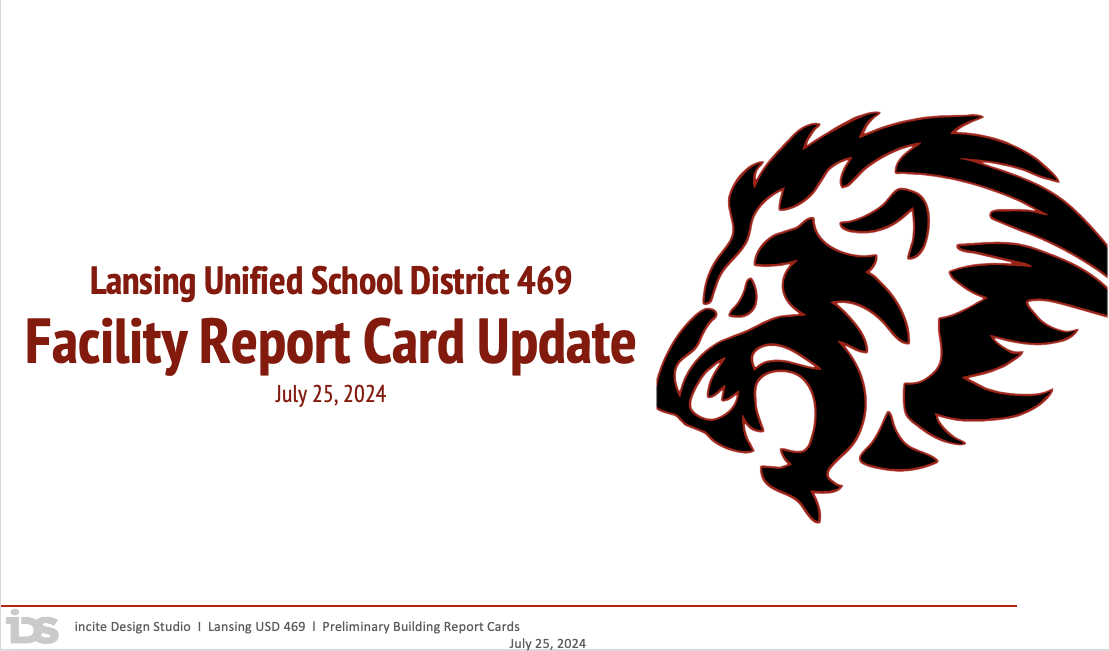Lansing USD469 Bond Information
Overview
The Lansing USD 469 Board of Education is reviewing facility needs and considering a potential March 3, 2026 bond election following the Special Board Workshop held on November 17, 2025. Superintendent Marty Kobza, architects from Incite Design Studio, and our financial advisor from Raymond James Public Finance presented information on district facility conditions, student needs, and financial impacts.
The Board will consider formal bond resolutions at its December 8, 2025 meeting.
If approved, the resolutions will place the bond questions on the ballot for the March 2026 election.
Why a Bond?
A bond allows school districts to fund major, long-term facility improvements that cannot be covered through regular annual budgets. Lansing USD 469 has reached a point where many building systems and safety components need significant upgrades that exceed operational funding capacity.
Key factors contributing to the need:
Aging roofs, HVAC systems, and electrical infrastructure
Safety and security upgrades
Growing needs for Career & Technical Education (CTE) space
Early childhood and specialized program needs
Districtwide asphalt and parking lot deterioration
Failing athletic surfaces at the middle school track and high school tennis courts
Guided by Community Input
In December 2024, the district conducted a scientific phone survey of 300 registered voters within district boundaries. Survey results showed:
Strong community support for: CTE expansion, behavioral support programs, early childhood investment, and safety improvements
Lower support for large-scale athletic additions
Higher approval for no mill levy increase or low-impact tax scenarios
These findings directly informed the recommended scope of the bond proposal.
Proposed Bond Structure
Based on the facility study, survey results, and Board direction, the proposed bond would include two questions:
Question 1 — Base Facilities Package (Approximately $30 million)
Focus areas include:
Early Childhood Center safety and system improvements
Roof and HVAC replacements
Electrical and plumbing upgrades
Security upgrades and secure entries
Parking lot and asphalt repairs
Middle school track replacement
High school tennis court reconstruction
Career & Technical Education (CTE) and alternative learning program space
Question 2 — Athletic Field Enhancements (Approximately $5 million)
This question would be separate and contingent upon Question 1 passing.
Tax Impact
Financial projections from Raymond James Public Finance show that:
Base Package – $30 Million
Can be structured to maintain the current mill levy (approx. 14.94 mills)
Individual tax bills may still fluctuate based on property valuation
If Both Questions are Approved – Total $35 Million
Estimated at approximately 0.75 mills higher
Less than $1 per month per $100,000 of home value
The district will publish calculated examples for homeowners at $100,000 intervals to help community members understand possible tax effects.
Facility Needs at a Glance
Early Childhood Center
Lowest-rated building in the district (“D” rating)
Roof, HVAC, restroom access, code compliance, and security needs
Proposed solution: targeted upgrades to improve safety and functionality without full reconstruction
Districtwide Improvements
Roof maintenance and replacement
HVAC modernization and preventative maintenance
Technology and security system replacement cycles
Parking lot/asphalt repair plan
Athletic Safety Needs
Middle School Track: severe base failure and surfacing loss; safety risk
High School Tennis Courts: heaving, cracking, water intrusion; liability concern
Long-Term Planning and Preventative Maintenance
The district is implementing several long-term maintenance strategies:
Computerized Maintenance Management System (CMMS) for preventative maintenance
12-year technology replacement plan
Roofing maintenance plan with professional consultants
Districtwide asphalt and parking lot rotation plan
Improved custodial and maintenance staffing to meet national standards
These efforts improve building longevity and reduce emergency repair costs.
Next Steps
December 8, 2025: The Board of Education will vote on the draft bond resolutions.
If approved:
The resolutions will be filed with the county and state
Election preparations will begin
The district will publish detailed project descriptions, tax examples, and FAQs
March 3, 2026: Proposed election date (walk-in voting)
Transparency Commitment
If the Board approves moving forward, Lansing USD 469 will provide ongoing updates, including:
Full project lists and cost estimates
Tax impact charts
Frequently Asked Questions (FAQ)
Informational videos
Community presentation materials
Meeting summaries and follow-up documents
Our goal is to ensure every Lansing resident has clear, factual information to make an informed decision.
Presentations from November 17, 2025 Special Board Meeting
Facilities study and community engagement
Our district has partnered with Incite Design Studio to evaluate our facilities and engage with our community as we shape a long-term vision for Lansing USD469. Through this collaboration, we aim to gather valuable feedback to identify and prioritize projects that will best support our students and ensure that our facilities meet the needs of our community. To keep everyone updated and informed throughout this process, we have included documents and videos below for the Lansing community to review.
Feedback from our Community Engagement Meetings held on August 27 and September 4, 2024


